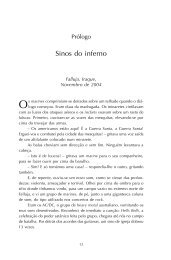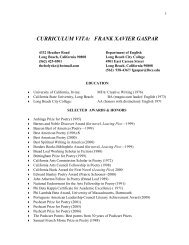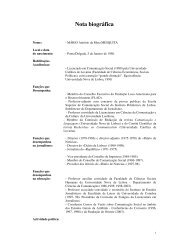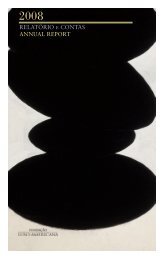A decade later - Fundação Luso-Americana
A decade later - Fundação Luso-Americana
A decade later - Fundação Luso-Americana
Create successful ePaper yourself
Turn your PDF publications into a flip-book with our unique Google optimized e-Paper software.
cuLTure<br />
Writers<br />
sylvia plath and<br />
the Falsity of the suicide myth<br />
My image of Sylvia Plath (n. 1932), is<br />
draped in a false suicide myth – like<br />
Marilyn Monroe and James Dean – relentlessly<br />
repeated by the voracious literary<br />
and media machines. It is true that she<br />
killed herself, in 1963, at the age of 30,<br />
in a frigid February in Primrose Hill,<br />
London, in the place she dreamed of living<br />
– a flat formerly inhabited by the poet<br />
Yeats. But she didn’t only die; she lived<br />
and wrote. She had just divorced Ted<br />
Hughes, a poet enthralled by astrology<br />
and the occult, who was <strong>later</strong> accused of<br />
thwarting her literary attempts, even<br />
though he did publish her poems, a diary,<br />
stories and correspondence. Like Dylan<br />
Thomas, another author she admired,<br />
Sylvia was born on October 27, in Boston.<br />
She was young and tulip-skinned with<br />
quick, restless hands that could not disguise<br />
a tracery of delicate blue veins.<br />
I envision her speeding on a bicycle over<br />
a mantle of dry leaves or leaping over stones<br />
as one bestriding a fish. I hear her obsessively<br />
laughing in metallic bursts with the<br />
water at her waist, when love, overwhelmingly<br />
material, comes too late in “bits of<br />
sweetened blood.” I see the shadow and<br />
light that made her depart, not only because<br />
lovers are not bonded forever, but because<br />
her feet were veiled by the shroud of a<br />
hollow world and her eyes were hollowedout<br />
orbs. She is there studying and reading,<br />
turned in on her writing and the words<br />
and gestures of others who were absent and<br />
fated not to return.<br />
Sylvia in her negative narcissism and<br />
overwhelming talent did not deem herself<br />
sufficient. Yet she believed she was a<br />
genius and said so in a letter to her mother.<br />
She rationalized her need to escape and<br />
yearned to write with “more inventiveness<br />
than God.” She sought the comforting crib<br />
By AnA mArques GAsTão<br />
Sylvia Plath<br />
of long-lost paternal warmth, and believed<br />
that the world was driven by hard work<br />
and dreams; she heard footsteps and voices<br />
and was inhabited by lunar cries: “If I<br />
sit still and don’t do anything, the world<br />
goes on beating like a slack drum, without<br />
meaning.” (Journal, 2/25/1956).<br />
Like Faust, she knew that there was a<br />
“quagmire at the foot of the mountain,”<br />
yet she could not bear the draining toil her<br />
work demanded. She left her life behind<br />
with no soothing balms or purges; the<br />
white lily of her sublimely ferocious pencil<br />
describing a wounded body with biletinged<br />
tears and words from a bottomless<br />
abyss. As in the Bell Jar, her seeming selfrevelations<br />
were, in reality symbolic, colloquial<br />
and pregnant with metaphors and<br />
transformed her mal-adjustment and<br />
strangeness into something that did not<br />
belong to her. And that is why she allowed<br />
herself to depart and chose to write “in<br />
line with the Poundian legacy between<br />
emotion and intellect” (Mário Avelar, Sylvia<br />
Plath, o rosto oculto do Poeta com uma antologia<br />
poética bilingue, Edições Cosmos, 1997), and<br />
then die: “O my God, what am I. That these<br />
late mouths should cry open. In a forest of<br />
frost, in a dawn of cornflowers.” (“Poppies<br />
in October” 1962)<br />
If anyone can actually be a poem, Sylvia<br />
Plath was Lady Lazarus, the title of a poetic<br />
monologue written eleven days after Daddy<br />
in October of 1962, that talks about once<br />
again being begrudgingly brought back<br />
from the brink of death: “Dying/Is an art,<br />
like everything else, I do it exceptionally<br />
well.” The verses are pervaded by pain,<br />
wit, and irony and pierced through and<br />
through by a kind of morbid joy, a sulphuric<br />
clamor, and haughtiness that the<br />
spoken word brings out: it is a work that<br />
must be heard – not merely read. As Maria<br />
Filomena Molder points out in A Imperfeição<br />
da Filosofia (Relógio d’Água, 2003), in a<br />
reference to a text by Paul Valéry, Lazarus<br />
“only comes back to life because he is<br />
still alive.” He is not a dying figure but a<br />
Christ figure.<br />
Lady Lazarus is the account of a crucifixion.<br />
After death, there is a revival. Skin, bones,<br />
knees, hands, scars, and the crown of gold<br />
are the symbolic elements that populate<br />
the spiritual path the fictional account<br />
details. In an archetypal approximation of<br />
the language of the depths, but with<br />
irresolute duality, the poem ends in a<br />
labyrinthine web of red hair. Sylvia rises<br />
from the ashes like the Phoenix – from<br />
the quagmire of nausea to a kind of occult<br />
eschatology. She has let herself be dragged<br />
to a better place perchance, where time<br />
no longer exists.<br />
Parallel no. 6 | FALL | WINTER 2011 79<br />
CORBIS/ VMI
















